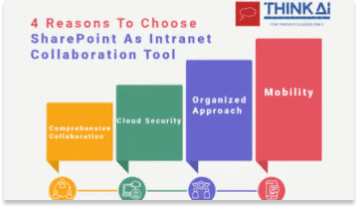“Great things in business are never done by one person. They’re done by a team of people.”
For the success of every business, collaboration is the cornerstone. Simply when people collaborate for a common motive, they share new ideas and collectively drive to attain a common objective.
A collaboration tool can be as easy as a whiteboard or as complicated as a document management portal or a web-based intranet.
 What Is The Need For Collaboration Tools?
What Is The Need For Collaboration Tools?
Collaboration tools have become important due to the change in work culture. Nowadays, to have teams where members are working in different parts of a country, even in different time zone is quite common. Teams can communicate, have meetings, discussions, share calendars, and stay updated on their work progress using a collaboration tool.
Advantages of SharePoint Collaboration Tools
For team communication and collaboration, SharePoint-based intranets are industry standards. It provides easy collaboration, secure document management, and mobility.
- Comprehensive Collaboration
SharePoint Intranet built on Microsoft 365 makes it possible for a business to host emails (using Outlook 365), store documents on shared drives (Using SharePoint and One Drive), track projects (using MS Projects), and manage schedules (using Planner) everything at a centralized place.
On top of it, the immense customization and scalability possibilities in SharePoint are unmatched. SharePoint-based Intranet helps create new departments and add newly hired employees (based on the organization’s hierarchy).
- Cloud Security
Data security is one of the most important benefits. In addition to easy accessibility and sharing ability, an organization also needs its data to be secure. With the help of the SharePoint security tool, an organization’s data is secure at multiple levels.
- Organized Approach
One of the key advantages of SharePoint Intranet is its organized approach to document management. Department-level document libraries coupled with nested folder structure make it easy to store, organize and share thousands of documents. To make it easy to search and filter, you can tag documents and folders under various categories, sub-categories, and keywords.
Another key advantage of SharePoint as a collaboration tool is versioning and sharing capabilities. You can create newer versions of documents as you make changes and move ahead. The latest version will also show up in the list, but if needed previous versions can be restored quickly using the edit history.
- Mobility
The most important feature of the collaboration tool is mobility. In modern remote work and flexible shift structure, employees may need to access their project site or document from anywhere in the world. Therefore, mobility is crucial in this dynamic workspace structure.
SharePoint Intranet truly serves the need for mobility. Your organization’s data is available anytime, anywhere, and on any device.
If you are willing to migrate to a more efficient work environment supercharged with SharePoint collaboration capability, visit www.thinkaicorp.com and start now.

Manish works primarily with implementing cutting-edge technology for thought leaders who can envision moving their company into the future of business. These technologies include application of Artificial Intelligence, chatbots, Business Intelligence, and Data Analytics through Power BI. He is your ideal partner to guide you through a complex technology transition in your business.
President of International Association of Microsoft Channel Partners (IAMCP) SoCal
Strong focus on customer service with a history of A++ client satisfaction
Awarded the 2019 IAMCP SoCal Partner Choice Award
Awarded the ABAOC 2019 Presidential Award of the year










